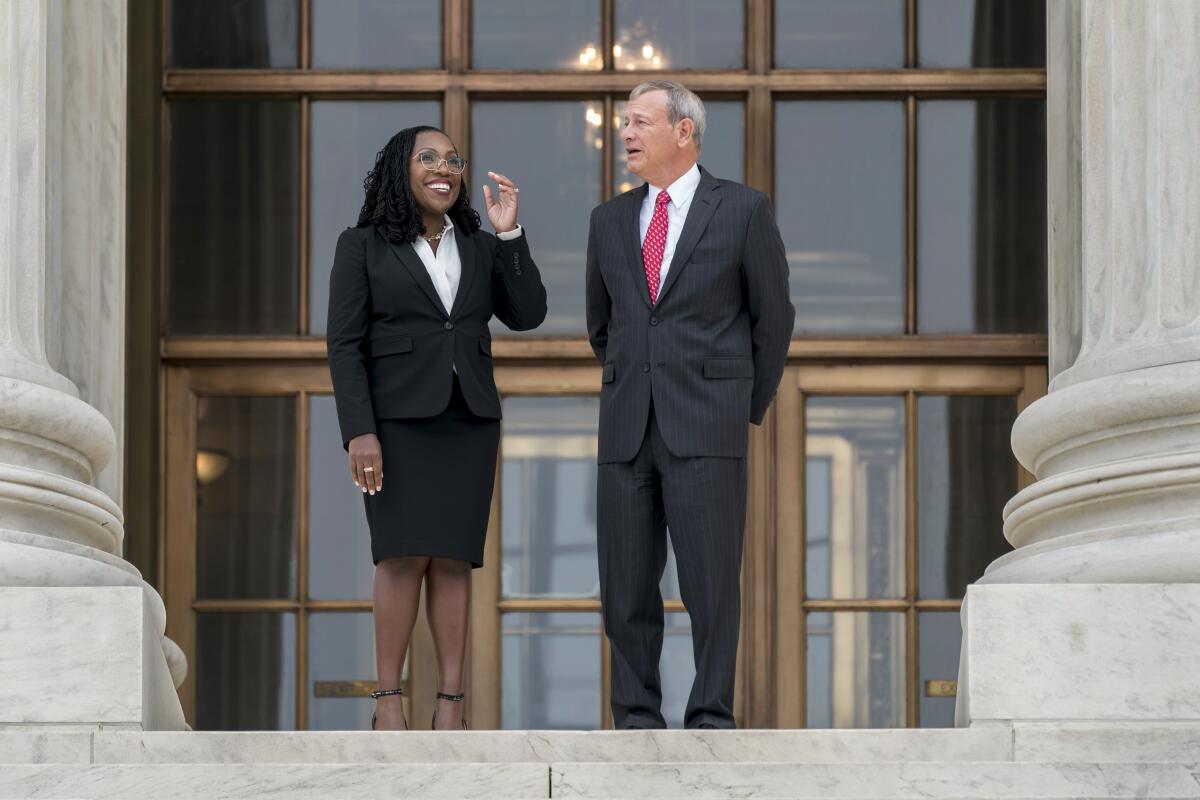Justice Jackson makes historic Supreme Court debut in brief ceremony

- Share via
WASHINGTON — Justice Ketanji Brown Jackson made her first appearance on the Supreme Court bench in a brief courtroom ceremony Friday, three days before the start of the high court’s new term.
President Biden, Vice President Kamala Harris and their spouses attended the invitation-only ceremonial investiture for Jackson, the first Black woman on the Supreme Court.
Chief Justice John G. Roberts Jr. wished the 52-year-old Jackson a “long and happy career in our common calling,” the traditional welcome for a new justice.
She took her place at the far end of the bench to Roberts’ left, next to Justice Brett M. Kavanaugh.
During the ceremony, Jackson also followed the custom of every other new justice since 1972 by sitting in a chair that once belonged to John Marshall, who served as chief justice for 34 years in the early 1800s.
Marshall was a slaveholder, which added a poignancy to Jackson taking her place in the chair. She is one of only three Black justices in the court’s history, along with her new colleague Justice Clarence Thomas and the late Justice Thurgood Marshall.
Friday’s ceremony included the reading of the commission appointing Jackson to the court. She also repeated the oath she took when she formally joined the court in June, just after the retirement of Justice Stephen G. Breyer.
Breyer was among the dignitaries in the courtroom Friday, along with House Speaker Nancy Pelosi (D-San Francisco) and former Speaker Paul D. Ryan (R-Wis.), who is related to Jackson through marriage.
Jackson’s parents, daughters, brother and in-laws all had front-row seats.
Several wives of current and former justices also attended, including Virginia “Ginni” Thomas. Thomas, a conservative activist and supporter of former President Trump, was interviewed Thursday by the House committee investigating the Jan. 6 insurrection.
The Senate confirmed Jackson in April on a 53-47 vote, with three Republican senators joining the Democratic Caucus in supporting her.
Her nomination and confirmation fulfilled Biden‘s presidential campaign pledge to put a Black woman on the Supreme Court.
Biden, Harris, First Lady Jill Biden and Second Gentleman Doug Emhoff spent a few minutes with the justices before the court convened, court spokeswoman Patricia McCabe said.
The president did not speak during the five-minute, tightly scripted courtroom ceremony.
Back at the White House, Biden tweeted in praise of Jackson’s “brilliant legal mind” and noted his record on filling judgeships.
“In fact, we’ve appointed 84 federal judges so far. No group of that many judges has been appointed as quickly, or been that diverse,” Biden said.
Jackson and Roberts walked down the 36 front steps of the court for photos after the ceremony. They chatted briefly on the court plaza, and when Roberts departed, the justice’s husband, Dr. Patrick Jackson, joined her.
“I’m so proud of you,” he said as they embraced in front of reporters and well-wishers.
Jackson is the first justice appointed by a Democratic president since Justice Elena Kagan joined the court in 2010. Kagan was appointed by former President Obama, who also appointed Justice Sonia Sotomayor in 2009.
It appeared Obama would get a third high court pick when Justice Antonin Scalia died in February 2016. But Senate Republicans refused to take up Obama’s nomination of Merrick Garland, then a federal appeals court judge, arguing that the next president should choose a replacement for Scalia.
Trump eventually chose Justice Neil M. Gorsuch to fill Scalia’s seat, and in 2018 nominated Kavanaugh to replace retiring Justice Anthony M. Kennedy.
He chose a third justice in September 2020, nominating Amy Coney Barrett eight days after the death of Justice Ruth Bader Ginsburg. Senate Republicans pushed to confirm Barrett just nine days before the presidential election — a move that many observers called hypocritical considering Republicans’ handling of Garland’s nomination when the 2016 election was several months away.
Garland, now attorney general, also participated in Friday’s ceremony.
Associated Press writer Seung Min Kim contributed to this report.
More to Read
Sign up for Essential California
The most important California stories and recommendations in your inbox every morning.
You may occasionally receive promotional content from the Los Angeles Times.










